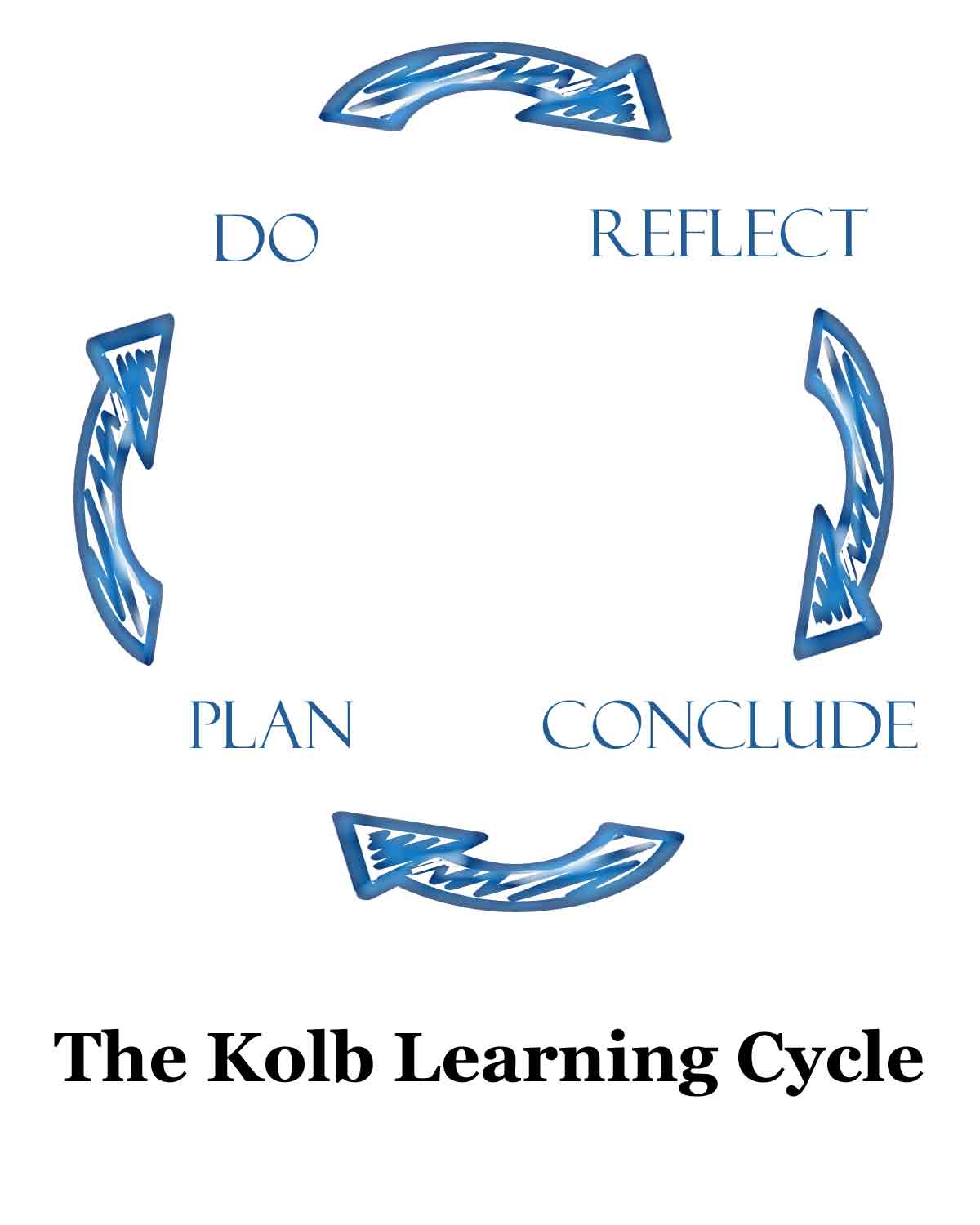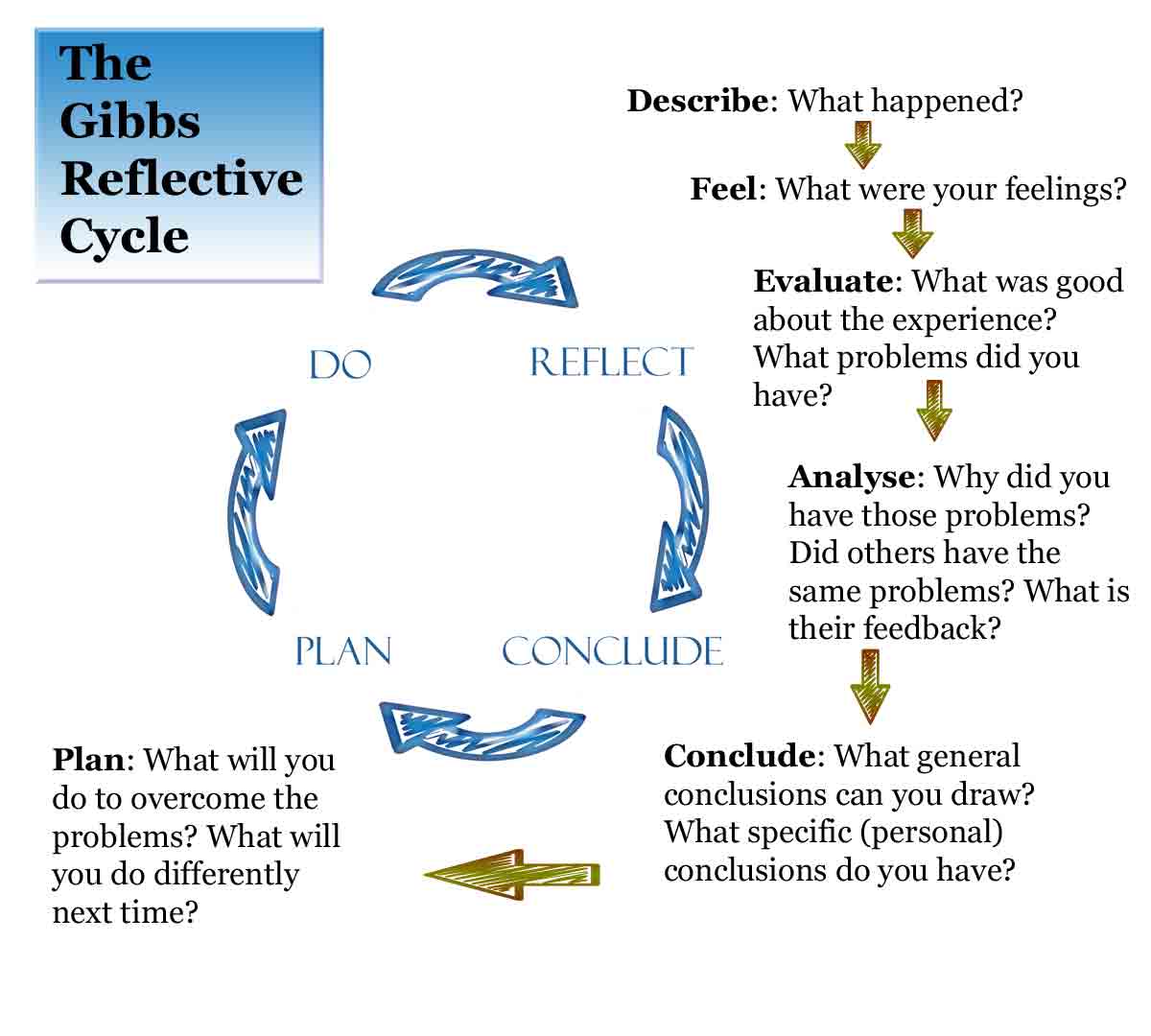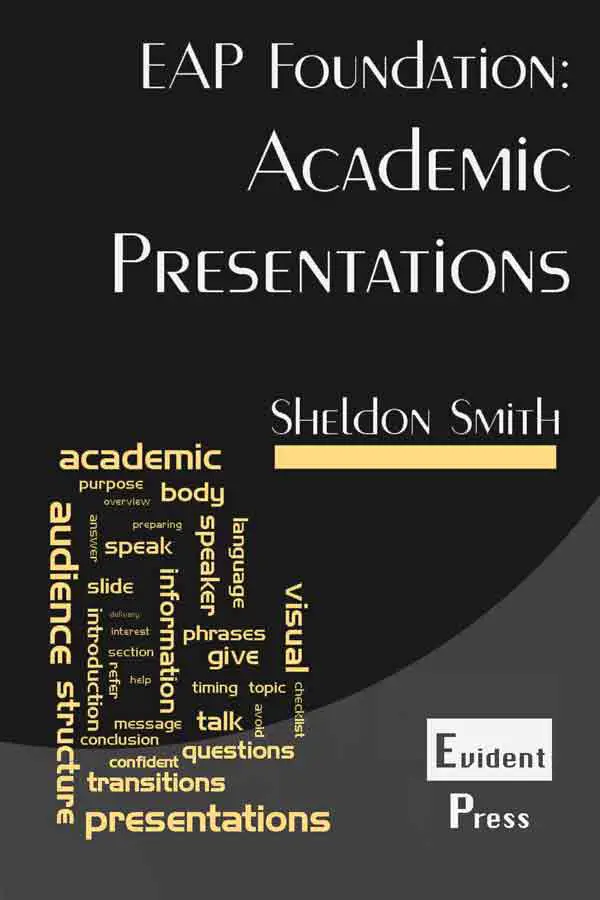Show AWL words on this page.
Show sorted lists of these words.


 







|
 Podcast is loading. Problems? Too slow? You can also access the Podcast by
clicking here.
Podcast is loading. Problems? Too slow? You can also access the Podcast by
clicking here.This message will disappear when then podcast has fully loaded.
Many courses now ask students to reflect on their learning, though not all students (and perhaps not all teachers) understand what this really means, why it is useful, and how to do it. Reflection is an important part of the learning cycle, and so in order to understand reflection and its importance it is necessary to understand more about the learning cycle first. As well as the above, this page includes an example reflection and a template to use for writing a reflection of your own.
The Kolb learning cycle

One of the most important ideas behind the learning cycle is that learning does not happen simply by doing. Most learning happens afterwards, as a result of reflecting on the experience, concluding, and planning what to do next. Learning does not end when an activity is finished, but continues afterwards in a continual loop. One of the most widely known learning cycles is the Kolb learning cycle, shown to the right. Although this is well known, it is not always the easiest one for students to use. Later, you will see a version of this cycle which will help you reflect more easily.
What is reflection?
'Reflection' here is similar to the literal (real) meaning of the word. It is like looking in a mirror, except instead of trying to see your face, you are trying to see your experience, in order to make sense of it and to identify what to do in the future. This does not have to be something you do on your own. If you look at your face in the mirror and see a mark or a scratch, you might ask someone, 'Can you see that on my face? What is it?' They can see it more clearly than you, and can give you better feedback. Getting feedback, from peers or from your tutor, are also important aspects of reflection in the learning cycle.
How to reflect

As mentioned above, the Kolb learning cycle is not the easiest one to use when it comes to reflection. A more user-friendly version is the Gibbs reflective cycle, shown in the diagram to the right. As can be seen from the diagram, it is based on the Kolb cycle. In the Gibbs reflective cycle, you should go through a series of stages which will get you to think about (reflect on) your experiences. This begins with fairly concrete questions that ask you to describe what happened, and how you feel. You should then evaluate the positives, which you want to repeat next time, as well as the negatives, which you want to improve. The questions become more abstract when you start to analyse and try to understand why you had the problems you did. This is where feedback, from peers or teachers, can be especially useful: it is not always easy to identify your own problems. Although the Kolb cycle shows reflect/conclude/plan as three separate parts of the cycle, many tutors, when they ask you to reflect, will expect you to do all three. The Gibbs reflective cycle includes these final two stages, and if you follow this cycle you will need to conclude what you have learnt from the experience, and to plan for future experiences.
In short, to reflect on your learning, you need to:
- Describe what happened
- Explain how you feel
- Evaluate the positives and negatives
- Analyse the reasons
- Conclude what you learnt from the experience
- Plan how to improve
Example reflection
Below is a reflection I wrote, describing my experiences teaching students about reflection and writing this web page. Click on the different areas to the right to highlight these in the reflection.
Describe |
Feel |
|
Evaluate |
Analyse |
|
Conclude |
Plan |
My students are getting ready to submit a reflective assignment. I have seen some of their drafts and can see that they have a general understanding of how to reflect, but tend to be too descriptive, without thinking deeply enough. I decided to add information to the website to help them. Although I had several handouts from which I could get information, I felt they were rather too simple. I therefore searched for more information about the learning cycle and reflection in text books and online. I was initially quite confused at the different models, none of which quite matched the one I was used to. I was a little worried that I had been teaching students in the wrong way. However, I found the different models and ideas stimulating, and liked the fact that the information challenged what I already knew and made me think more deeply. After reading more about the topic I felt I already had a good understanding of what reflection means, but I had problems deciding how to present it in a useful way on the website. This is partly because of the many different models, which I felt would confuse my students. It is also because the website information needs to be fairly brief, but at the same time needs to be accurate and useful. In a lesson, I can help students by adding explanations and working individually with them, but on the website, I cannot do this. I discussed the information with colleagues, which helped to clarify my ideas. I also asked them to look at this page on the website and give me some feedback, which also helped to improve the content. I came to the conclusion that although the Kolb cycle is well-known and is a useful one to start with, the Gibbs cycle has more structure, with a clearer set of stages and questions to help students reflect. As mentioned above, my students' reflections tend to be too descriptive. One advantage of using the Gibbs cycle is that it shows students they have made a useful beginning (by describing), but that this is only a first step towards reflection, and they need to go further by explaining how they feel, by evaluating, analysing, concluding and planning. Once the information is on the website and I have used it to guide students in their reflection, I will examine how well students use this information to reflect, and consider how it can be improved to help other students in the future.
Describe |
Feel |
Evaluate |
Analyse |
Conclude |
Plan |
Template
Below is a template for writing a reflection, based on the Gibbs reflective cycle above.
Questions to help you reflect |
Write your reflection here |
|
Describe: What happened? |
Next section
Read more about learning styles in the next section.
Previous section
Go back to the previous section describing what study skills are.
Exercises & ActivitiesSome ways to practise this area of EAP
You need to login to view the exercises. If you do not already have an account, you can register for free.



